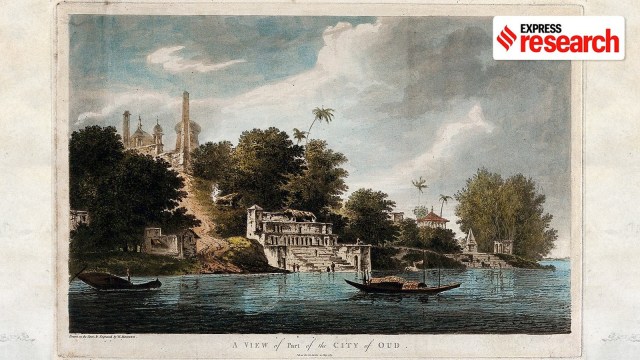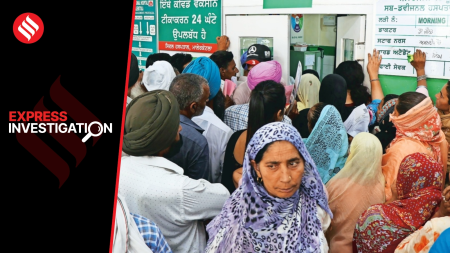- India
- International
‘Many Ayodhyas, but name of Ram’s birthplace same in all versions of Ramayana’
It is worth noting that apart from the present site of the temple, the name Ayodhya exists in other parts of the world as well. Journalist and researcher Valay Singh, who has authored the book, ‘Ayodhya: City of faith, city of discord’ (2018), spoke to indianexpress.com on several aspects of the name ‘Ayodhya’ and how it traveled not just across India but also beyond its borders.
 Ayodhya in 1785 as seen from river Ghaghara; painting by William Hodges. (Wikimedia Commons)
Ayodhya in 1785 as seen from river Ghaghara; painting by William Hodges. (Wikimedia Commons)The construction of a Ram Temple in Ayodhya, Uttar Pradesh has for decades been the demand of the Hindu Right in India. The demand rests on two important claims, both of which are a point of contention among historians and politicians. First, there is the belief that Ayodhya is the sacred site of birth of Lord Ram, and second is the claim that a temple dedicated to Ram was demolished on the orders of the 16th century Mughal emperor Babur to build a mosque at the same site.
Ayodhya’s sanctity as the birth place of Ram is derived from the faith that Hindus place on the Ramayana. It is worth noting that apart from the present site of the temple, the name Ayodhya exists in other parts of the world as well. There is the Ayutthaya kingdom in Thailand that is known to have been named on the Ayodhya of the Ramayana and there is also a place named Ajudhiapur in present-day Pakistan.
Journalist and researcher Valay Singh, who has authored the book, ‘Ayodhya: City of faith, city of discord’ (2018), spoke to indianexpress.com on several aspects of the name ‘Ayodhya’ and how it traveled not just across India but also beyond its borders. Edited excerpts:
 Journalist Valay Singh who has authored the book, ‘Ayodhya: City of Faith, City of Discord’ (Aleph, 2018)
Journalist Valay Singh who has authored the book, ‘Ayodhya: City of Faith, City of Discord’ (Aleph, 2018)Do we know if the Ayodhya mentioned in the Ramayana is the same as the site where the temple is being built?
There are so many Ramayanas; let’s take the Valmiki Ramayana. The descriptions given in it are not corroborated by all the excavations that have been done so far. There is no way to conclude that it is the same Ayodhya, it could also be that the site is now submerged under the Ghaghara/Sarayu river. The paucity of evidence of the kingly Ram has been replaced by faith in the godly Ram, and thus, the Ayodhya of today encapsulates both Ram Rajya and Ram worship.

Was Ayodhya the name of Ram’s birthplace in other versions of the Ramayana as well? How did the name gain popularity among writers from diverse backgrounds?
A story can be retold in countless ways. This is true of the Ramayana which has several versions and interpretations. Buddhists and Jains have rewritten the Ramayana to suit their own ideology. A comparative reading of these different Ramayanas along with the Valmiki and Tulsidas versions throws up some obvious patterns. The central themes for the Jains are deeksha and nirvan (renunciation and liberation), for Valmiki and Tulsidas they are dharma (duty) and Brahminism, while the Dashrath Jatakas of Buddhism are smaller in scale and more practical in outlook. Besides these variations, there are several differences in the religious structure of these tellings.
Some scholars believe that the Dashrath Jataka, which is set in Banaras (or Varanasi) and not Ayodhya, is the oldest version of the Ramayana while others argue that it was written after Valmiki’s. There is inadequate evidence for both assertions and this matter remains inconclusive. Others argue that it was probably an oral folk tradition, which was compiled into an epic-poem by Valmiki. Be that as it may, unlike the voluminous Ramayana by Valmiki, the Dashrath Jataka is less than 2,000 words.
Other than the Buddhist version though, the name of Ram’s birthplace as Ayodhya remains the same in almost all versions and recensions of the Ramayana. That has to be traced back to the popularity of the Ramayana as an epic itself, so one would not want to change the name. Wherever the Ramayana went, it was adapted to local mores and customs. The basic shell remained largely unchanged. But in terms of archaeological evidence, it is not clear if it is the same Ayodhya as the site on which the temple is being made.
Are there other parts of India and southeast Asia where the name Ayodhya occurs? If so, how do you explain this?
It is highly likely that the Ramayana left India’s present shores even before it reached the four corners of the country. It is believed that the Ayutthaya kingdom of Thailand was based on the Ayodhya of the Ramayana and shows the once widespread influence of pantheistic Hinduism in Thailand (then Siam) since at least the latter half of the first millennium of the Common Era. Bound by a large river on three sides, old maps of Ayutthaya bear a striking geographical resemblance to Ayodhya as described in the epic. In 1350 CE, the Ayutthaya kingdom had been shifted about 150 km north of present-day Bangkok by a man who had also used the legitimising power of Ram by calling himself King Ramathibodi (from the order of Rama).
 Painting of Ayutthaya c. 1665, painted by Johannes Vingboons, ordered by the Dutch East India Company, Amsterdam. (Wikimedia Commons)
Painting of Ayutthaya c. 1665, painted by Johannes Vingboons, ordered by the Dutch East India Company, Amsterdam. (Wikimedia Commons)
There is also an area in Lahore that goes by the name Ajudhiapur; in the same way there is an area in West Bengal’s East Medinipur district that goes by the name Ajodhyapur, and Ajodhya in the Purulia Hills district of the state. One can infer the extent to which the Ramyana may have influenced the naming of these locations, particularly in undivided India. Interestingly, while Persian translations of the Ramayana can be traced back to Mughal times, the earliest known Ramayana story in Urdu dates back to 1864. It was written by Munshi Jagannath Lal Khushtar and published by Nawal Kishore Press, Allahabad. It came to be known as Khushtar Ramayana and begins with the words ‘Bismillah ir Rehman ir Rahim’.
There are multiple places in India of modern times that are named as Ayodhya. That is also because people name their children and places after popular pilgrimage spots. In Bhopal, for instance, there is an Ayodhyapuram.
Aside from mythological sites, we see similar phenomena happening even with contemporary names of places. An example of that would be the Marine Drive. For the longest time, there was just one in Mumbai. Now, you have a Marine Drive in Raipur, Patna, Bhopal. When something gains a lot of popularity, there is a tendency for people to name their own places after it.
Do we know how the current site of Ayodhya in UP came to be named?
It’s nearly impossible to say how with certitude. Out of their 23 spiritual teachers or tirthankars, five (seven, according to scholars like Hans Bakker) are believed by Jains to have been born in Ayodhya, and three of them in not-too-distant Banaras. Jains believe that Ayodhya means a place ‘without war’ and Awadh means a place where there is ‘no killing’. But it would be hard to suggest if the current name came from Jain sources.
Ayodhya is also said to be known by other names. It is on the basis of the Puranas and epics like Valmiki’s Ramayana that Buddha, Ram and Ram’s ancestors like Ikshvaku, and Harishchandra were said to have lived in the kingdom of Kosala. Therefore scholars have identified Kosala as one of the names used for Ayodhya. Religious texts also suggest that around the fifth century BCE, in the kingdom of Kosala, there was a busy town at the intersection of two major routes, one going from Sravasti in the north to Pratishthana (Maharashtra) in the south, and the other going to Taxila in the west from Rajagriha in the east. This town was Saket and its king was Prasenjit, who ruled from his capital, Sravasti, about 80 km from Saket. Prasenjit is also known as the king of Kosala.
Another question also asked (is) if Saket and Ayodhya are interchangeable, or if Saket was located in Ayodhya. We don’t know that for sure, but we do know Saket had become a large and important city in the time of the Buddha, evidenced by accounts of his visits. Even though many historians — and several texts — attest to Saket and Ayodhya being one and the same place, there is no consensus on it. However, with the coming of new rulers the legend of Saket and Ayodhya being one gained more strength. One such example was the Gupta ruler Skandagupta (Skanda means spilling or spurting, a likely allusion to bloodshed).
It is also believed that during the time of the Guptas there was a Brahmanical revival and the town of Saket reacquired prominence. Scholars hold the belief that Gupta kings consciously worked to increase the importance of Ayodhya because they wanted to use the idea of the avatar of Ram to support their deification of kings.
Skandagupta is also believed to have moved the capital of the Guptas from Pataliputra (Patna) to Saketa. One city, many histories, many names.
Apr 04: Latest News
- 01
- 02
- 03
- 04
- 05








































